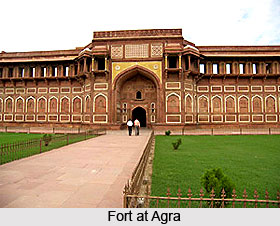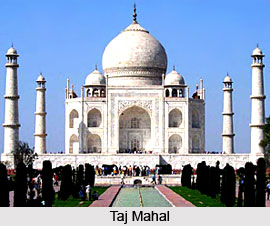 Islamic architecture which stands as the logo of artistic excellence has a rich history of its own. With its copious timeline associated with the Muslim invasion Islamic architecture gradually developed as a distinct art form in India. The development of Islamic architecture therefore itself is a history. In India the development of Islamic architecture took place under the patronage of the ruling power at Delhi. When the Saljuqian influence declined, the architectural movement from the another source blended with it, and later started to dominate as the main architecture of India while adding a peerless identity to Islamic architecture
Islamic architecture which stands as the logo of artistic excellence has a rich history of its own. With its copious timeline associated with the Muslim invasion Islamic architecture gradually developed as a distinct art form in India. The development of Islamic architecture therefore itself is a history. In India the development of Islamic architecture took place under the patronage of the ruling power at Delhi. When the Saljuqian influence declined, the architectural movement from the another source blended with it, and later started to dominate as the main architecture of India while adding a peerless identity to Islamic architecture
The development of Islamic architecture mainly happened in the medieval period. The structures of this period were known as Indo-Islamic architecture. These were the combination of both the Hindu and Islamic architecture. With the development of the Islamic architecture in India two different categories of Islamic architecture came into being. They are the Imperial Style and the Mughal Architecture. The first one was developed under the Sultans of Delhi whereas the Mughal architecture was the combination of Hindu architecture with the Islamic architecture of Central Asia.
The Imperial style which evolved with the development of Islamic architecture was derived from the existing art of Persia and formed under the Timurid rulers of the 15th and 16th centuries. These can be understood by the shape and treatment of the essential element in building construction-the arch. It was pointed horse-shoe arch, decoratively attractive, however its narrow compass was not sufficiently satisfying when wider spaces were to be spanned. It had abundant intervals between the jambs, or side-posts, of the openings. The application known as the four-centred or "Tudor" arch, a shape frequently used in the building of the Timurids, solved the problem.
 But the introduction of this feature into the architecture of northern India was hesitant. Indian masons were not comfortable to the architecture and in order to make their construction strong, they reinforced their work in the indigenous manner. This technique added splendor to the development of Islamic architecture. Tughlaqs following this tradition in the 14th century used the combination of arch and beam, well illustrated buildings as their architecture, which later changed into a true- four-centred arch, without the additional support. These were used in the tombs and mosques of the Sayyids and Lodis in the 15th and 16th centuries. The talented Persian craftsmen often used marvellous textiles and shiny stoneware in their architecture. They also used plastic materials, such as brick and glazed tiles, and made their architecture lavish and brilliant colour. The dome that was put into practice by the Persian builders, were accepted by the masons working in India, however, few changes were made in their technical treatments along with the use of different materials and methods.
But the introduction of this feature into the architecture of northern India was hesitant. Indian masons were not comfortable to the architecture and in order to make their construction strong, they reinforced their work in the indigenous manner. This technique added splendor to the development of Islamic architecture. Tughlaqs following this tradition in the 14th century used the combination of arch and beam, well illustrated buildings as their architecture, which later changed into a true- four-centred arch, without the additional support. These were used in the tombs and mosques of the Sayyids and Lodis in the 15th and 16th centuries. The talented Persian craftsmen often used marvellous textiles and shiny stoneware in their architecture. They also used plastic materials, such as brick and glazed tiles, and made their architecture lavish and brilliant colour. The dome that was put into practice by the Persian builders, were accepted by the masons working in India, however, few changes were made in their technical treatments along with the use of different materials and methods.
 As the control of the country passed into the hands of the Mughuls, the "Persianization" of all cultural pursuits became more pronounced, developed during the reign of the Emperor Akbar (1556-1605). He incorporated the Persian influence into indigenous style. Thus the development of Islamic architecture took a new turn while paving way to the awesome emergence of the Mughal architecture.
As the control of the country passed into the hands of the Mughuls, the "Persianization" of all cultural pursuits became more pronounced, developed during the reign of the Emperor Akbar (1556-1605). He incorporated the Persian influence into indigenous style. Thus the development of Islamic architecture took a new turn while paving way to the awesome emergence of the Mughal architecture.
During this period the building arts, were developed in the indigenous styles of India as may be seen within the Fort at Agra, and the city of Fatehpur Sikri. However, Persian architecture was merged with regional modes that were readily distinguishable. Later, in the period of Shah Jahan (1627-58), whose luxurious building schemes ended as the world-renowned Taj Mahal. Glazed bricks were used for the entire structure. The double domes and recessed arcades of the Safevid period, resembles the cities as Ispahan and Tabriz, were to a certain extent, reproduced in tangible form. The surface colour was beautiful and the sandstone masonry and white marble overlay of the Mughuls. Earlier red sandstone was used in their art, however; it was replaced by white marbles, coloured designs and semi precious stones. These feature later silhouetted the Islamic architecture.
During the development of Islamic architecture in India, outstanding architecture of Fatehpur Sikri, Taj Mahal, Qutub Minar, Tughlaqabad Fort, Red Fort, Agra Fort, Ardhai-Din-Ka jhompra came into existence.



















